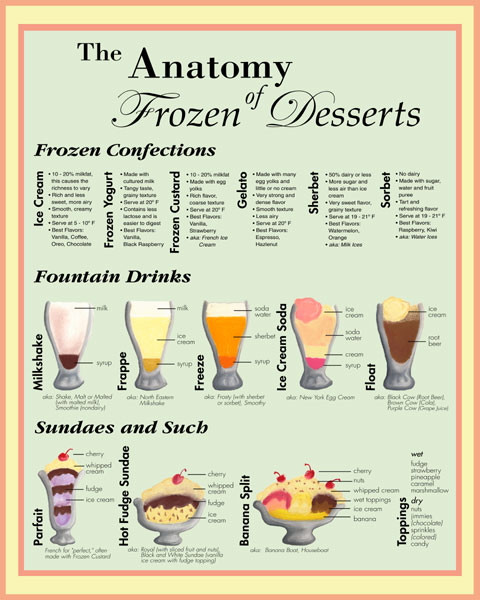Information Design: Difference between revisions
Jump to navigation
Jump to search
No edit summary |
No edit summary |
||
| Line 3: | Line 3: | ||
[[Image:icecream.jpg|thumb|Information Design Example]] | [[Image:icecream.jpg|thumb|Information Design Example]] | ||
{{Quotation|Information design is about the clear and effective presentation of information. It involves a multi and inter-disciplinary approach to communication, combining skills from graphic design, technical and non-technical authoring, psychology, communication theory and cultural studies. In fact, wherever relatively complex information needs to be made easier to understand, or tailored to the needs of a specific 'specialist' or cultural community, the 'user-oriented' methods of information design can be employed. [...]|[Burmester et al., 2004]}} | {{Quotation|'''Information design''' is about the clear and effective presentation of information. It involves a multi and inter-disciplinary approach to communication, combining skills from graphic design, technical and non-technical authoring, psychology, communication theory and cultural studies. In fact, wherever relatively complex information needs to be made easier to understand, or tailored to the needs of a specific 'specialist' or cultural community, the 'user-oriented' methods of information design can be employed. [...]|[Burmester et al., 2004]}} | ||
{{Quotation|'''Information Design''' is the detailed planning of specific information that is to be provided to a particular audience to meet specific objectives. The output of Information Design consists of visually delivered information which is highly designed for the benefit of the user.<br>Its mandate is to optimize the layout of information which facilitates navigation, readability and immediate understanding of what the information communicates. The purpose of Information Design is to Simplify, Integrate, Filter and Selectively Emphasize information.<br>Information Design is all about the psychology and physiology of how users access, learn, and remember information; the impact of colors, shapes, and patterns, learning styles.<br><br>Information Design takes pride in analyzing and identifying what works, what doesn't and why, in those situations where information is to be easily understood and comprehended.<br>Information Design usually encompasses many different responsibilities and tasks, including:<br>a) Analysis of users' needs and learning styles<br>b) Selection of the most effective layouts, colors, fonts, and graphics<br>c) Identification of most effective navigational infrastructures<br>d) Application of principles of simplification, synthesis and integration<br>e) Testing of readability, contrast and legibility in adverse situations and for handicapped users|[Rossi, 2001]}} | |||
== References == | == References == | ||
*[Burmester et al., 2004]: Prof. Dr. Michael Burmester, Bachelor-Studiengang ''Informationsdesign''. Fachhochschule Stuttgart, 2004. | |||
*[Rossi, 2001] Luigi Canali De Rossi: What is Information Design. ''MasterViews International''. Created at: November 15, 2001. Retrieved at: November 2004. http://www.masterviews.com/2001/11/15/what_is_information_design.htm | |||
*[Thissen, 2004]: Frank Thissen, [http://v.hdm-stuttgart.de/projekte/infodesign/i/informationsdesign.html ''Lexikon des Digitalen Informationsdesigns: Informationsdesign''], 2004. | *[Thissen, 2004]: Frank Thissen, [http://v.hdm-stuttgart.de/projekte/infodesign/i/informationsdesign.html ''Lexikon des Digitalen Informationsdesigns: Informationsdesign''], 2004. | ||
== External Links == | == External Links == | ||
Revision as of 13:30, 12 September 2005
Information design is about the clear and effective presentation of information. It involves a multi and inter–disciplinary approach to communication, combining skills from graphic design, technical and non–technical authoring, psychology, communication theory and cultural studies. [Thissen, 2004]

Information design is about the clear and effective presentation of information. It involves a multi and inter-disciplinary approach to communication, combining skills from graphic design, technical and non-technical authoring, psychology, communication theory and cultural studies. In fact, wherever relatively complex information needs to be made easier to understand, or tailored to the needs of a specific 'specialist' or cultural community, the 'user-oriented' methods of information design can be employed. [...]
[Burmester et al., 2004]
Information Design is the detailed planning of specific information that is to be provided to a particular audience to meet specific objectives. The output of Information Design consists of visually delivered information which is highly designed for the benefit of the user.
Its mandate is to optimize the layout of information which facilitates navigation, readability and immediate understanding of what the information communicates. The purpose of Information Design is to Simplify, Integrate, Filter and Selectively Emphasize information.
Information Design is all about the psychology and physiology of how users access, learn, and remember information; the impact of colors, shapes, and patterns, learning styles.
Information Design takes pride in analyzing and identifying what works, what doesn't and why, in those situations where information is to be easily understood and comprehended.
Information Design usually encompasses many different responsibilities and tasks, including:
a) Analysis of users' needs and learning styles
b) Selection of the most effective layouts, colors, fonts, and graphics
c) Identification of most effective navigational infrastructures
d) Application of principles of simplification, synthesis and integration
e) Testing of readability, contrast and legibility in adverse situations and for handicapped users
Its mandate is to optimize the layout of information which facilitates navigation, readability and immediate understanding of what the information communicates. The purpose of Information Design is to Simplify, Integrate, Filter and Selectively Emphasize information.
Information Design is all about the psychology and physiology of how users access, learn, and remember information; the impact of colors, shapes, and patterns, learning styles.
Information Design takes pride in analyzing and identifying what works, what doesn't and why, in those situations where information is to be easily understood and comprehended.
Information Design usually encompasses many different responsibilities and tasks, including:
a) Analysis of users' needs and learning styles
b) Selection of the most effective layouts, colors, fonts, and graphics
c) Identification of most effective navigational infrastructures
d) Application of principles of simplification, synthesis and integration
e) Testing of readability, contrast and legibility in adverse situations and for handicapped users
[Rossi, 2001]
References
- [Burmester et al., 2004]: Prof. Dr. Michael Burmester, Bachelor-Studiengang Informationsdesign. Fachhochschule Stuttgart, 2004.
- [Rossi, 2001] Luigi Canali De Rossi: What is Information Design. MasterViews International. Created at: November 15, 2001. Retrieved at: November 2004. http://www.masterviews.com/2001/11/15/what_is_information_design.htm
- [Thissen, 2004]: Frank Thissen, Lexikon des Digitalen Informationsdesigns: Informationsdesign, 2004.